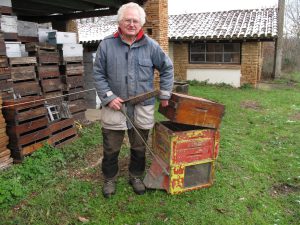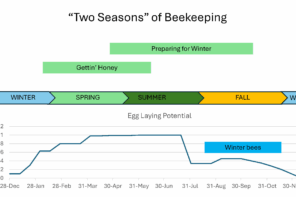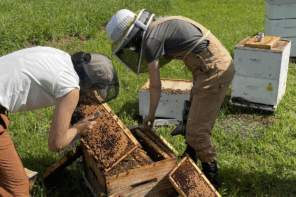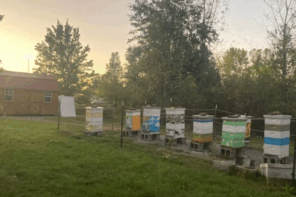By: John Kefuss
In 1975, I went to Weaver Apiaries in Navasota, Texas to learn commercial queen rearing and package bee production. At that time, Weaver Apiaries was producing 50,000 queens and 15,000 packages of bees a year. Today, they are producing much more. I started beekeeping in Canton, Ohio when I was 11 years old. But I did not have much experience in queen rearing and no experience in package bee production. So I knew that I needed more practical experience. For that reason, I went to Weaver Apiaries to get it hands on. If you are going to make mistakes, it is better to do it on someone else’s bees instead of your own. It’s a lot cheaper.
The year before, I had just finished my PhD studies under Dr. F. Ruttner in Oberursel, Germany, where I had studied the effect of photoperiodism on honey bee colony development. I applied for a research position at the honey bee research lab in Davis, California but I was among the numerous applicants that did not get the position. At that time, there were not many job openings available in bee research, so I decided to go from Frankfurt, Germany where I had studied Zoology to Toulouse, France to keep bees. The choice was simple, my wife is from Toulouse and the climate was good for bees.
When I got back from Texas, I began my queen rearing business “Le Rucher D’Oc”. Then I joined the ANERCEA (French queen breeders association) not long after it was formed by Charles Goetz. In January 1982, I gave a talk at Lyon, France to the ANERCEA and later the ANERCEA published my price list free of charge for queens and insemination services (Tome 1 pages 146-148). This was probably the ANERCEA’s first announcement for selling queens.
Before I left for Texas, I knew that there was a market for package bees in Europe, so I joined forces with Jean and Jacques Hollander and a few other beekeepers to produce swarms. They furnished the bees and I furnished the queens. One year we had an order for 100+ swarms of French Black bees for exportation to England. The English did not wish for yellow Italian bees, they only wished for French black bees. At that time, our French black bees were real stingers. They stung faster than a flash of lightning. But that is another story.
Several months before the shipment, I went to the French customs service at Portet-sur-Garonne to take care of the exportation paperwork. Not so easy for an American even with a “Toulouse accent”. But I am used to solving problems because I have them all the time. Actually, I am surprised when I don’t have any problems. I filled out their customs papers and paid the cash deposit that they requested. Everything had to be coordinated in advance because the packages were to be driven from Toulouse, in the South of France up to Dunkirk, in the north of France to be shipped by boat to England. At that time, it was a good days drive when things went well.
I pulled out the queens the day before we shook the packages. The rainy weather was not good on the day we shook the bees. We were wet to the skin. Our bee suits stuck to our bodies. The bees were so mean that they stung everything that moved. A big brown hawk that was sitting in a tree watching us was stung so bad that it fell to the ground on its back with its wings completely spread out like it was nailed to a cross. Its beak was wide open as if it was trying to scream but it did not make a sound. I still feel pity for that bird. Jacques Hollander’s bee veil was too close to his ears and he put scotch tape on his ears to protect them. He was shaking bees in open sandals with no socks but did not get any stings on his feet. I had a few small holes in my bee suit and of course the bees found them. I had the feeling that more bees were crawling inside than outside my bee suit. I got stung in a few areas that I won’t mention. I was not crying, but at one point a stream of “water” came out of my eyes. On the positive side, after the first 30-50 stings I did not feel the additional stings or pain anymore. Just a warm feeling. It was shake bees as usual and get the job done.
We took the packages back to Hollander’s honey house in Toulouse and prepared them for shipping. Then, we drove the bees to the customs service at Portet-sur-Garonne to complete the customs inspection and paperwork. We were wet, covered with mud, bee stingers, hadn’t shaved for a few days and probably did not smell or look very good. Someone you really would not like to meet at night in the dark. But for us, the main thing was that the packages were in the truck and ready to go.
At the customs service, I handed them the paperwork and told them that the truck (the English vehicle with its steering wheel on the right side), was driving in a clockwise circle in the customs loading area below with its rear doors open to keep the bees cool. When they were ready we would stop the truck so that they could inspect the packages. The officer asked me if I was a transit agent and I said no, but that several months earlier I had visited the customs office to check out their conditions, filled out the papers and paid them their fee. He shook his head and said “This is France… we don’t do things that way” and refused to sign the papers. Then he sent me upstairs to the third floor to talk with the director. The answer again was an emphatic no. When I went back downstairs the agent who had refused to sign my papers angrily waved me into his office, stamped my papers and told me in a very strong voice “Here’s your papers, never come back!” At the time, I did not understand why they had suddenly decided to complete the paperwork. But you know people do change their minds, so being polite I did not ask him why. You can’t imagine how good I felt when I got the paperwork completed and was able to get out of that building. Some feelings just can’t be explained.
A few moments later, I found out why the paperwork was so quickly completed. The English driver told me that while I was in the building trying to get the papers signed, a group of angry French bees that were on the outside of the packages flew out of the truck and quickly stung up the customs inspectors and people on the loading platform. The customs employees closed all the doors to the customs loading platform, which completely blocked all customs activities for everyone else. The English driver said that there were two to three people looking out every window of the three story administrative building at the action that was taking place in the courtyard below. Perhaps they were attracted by the screams and rapid movements of the customs employees and customers running inside and closing the big doors. But thanks to the bees, the customs agents got the point and we got our administrative papers. “Nature” has a way of solving complex problems. Sometimes the solution is simpler than you think! We left the customs buildings as fast as possible and never came back.










